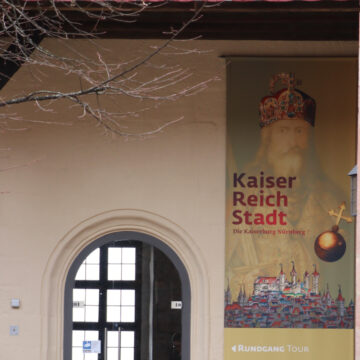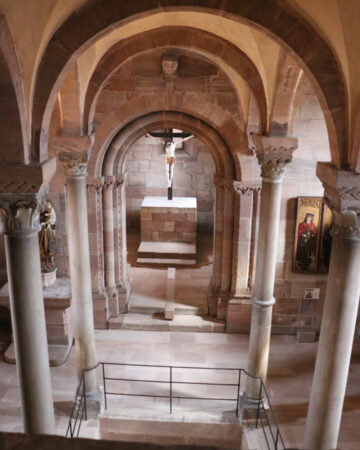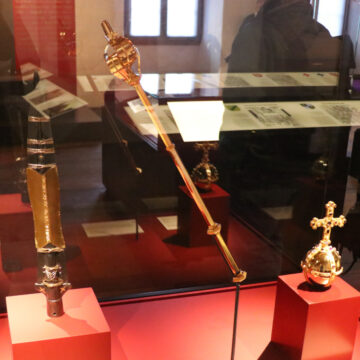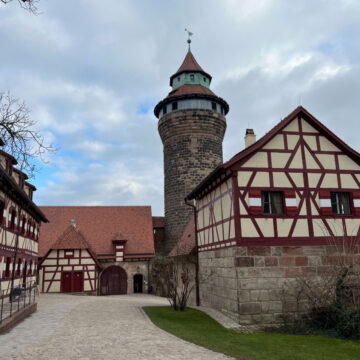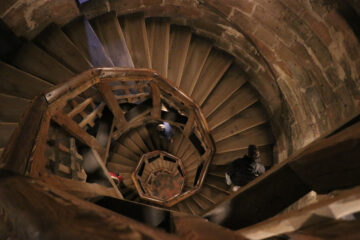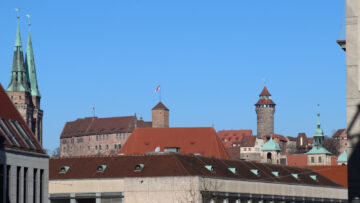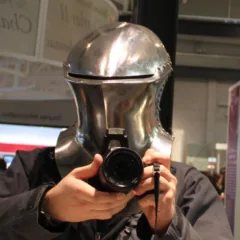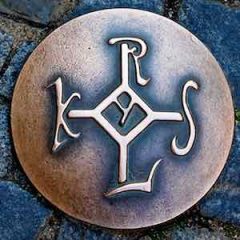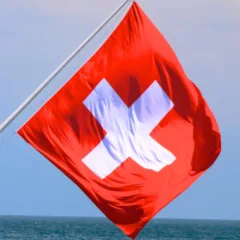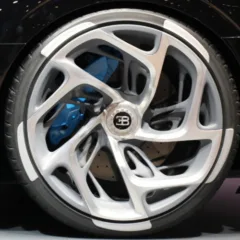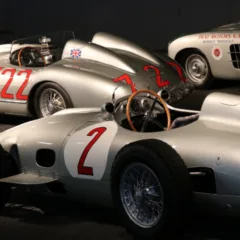The Kaiserburg Nürnberg was an imperial castle visited around 300 times by the Holy Roman emperors and is a top sight to see in Nuremberg, Germany.

The Imperial Castle (Kaiserburg) towers over the old town center of Nuremberg as the city’s symbol and a reminder of its glorious past. For centuries Nürnberg was one of the largest and richest free imperial cities famous for its arts, crafts, and trade. It hosted around 300 imperial visits during which times the emperor usually stayed in the Kaiserburg, which was reserved for his personal use. This large castle fortress complex is a mix of the medieval original and modern reconstructions but is absolutely worth visiting to see both the architecture and interesting exhibitions. The Nuremberg City Card is accepted.
Kaiserburg Nürnberg — Nuremberg Imperial Castle

The Holy Roman Empire of the German Nation (and all its various other names) had no permanent capital city and as the emperor was elected, he constantly moved with his entourage throughout the empire to at least try to confirm and establish his control.
For centuries, Nuremberg was at the geographical center of the empire and hosted around 300 imperial visits. Between 1050 and 1571, every crowned emperor visited Nuremberg at least once. Kaiser Karl IV (Charles IV) visited 52 times and Ludwig the Bavarian 74 times. Nuremberg accepted the Lutheran Reformation in 1524 and as a result, the catholic Habsburg emperors mostly avoided the city in favor of Regensburg, which became home of the permanent Imperial Diet from 1663 until the end of the empire in 1806.
The Kaiserburg Nürnberg was one of only a handful of palaces reserved for the exclusive use of the emperor (Kaiser). Between visits, a Burggraf resided in a small part of the fortress complex but the main palace remained empty. In 1191, the Count of Zollern became the Burggraf but Kaiser Sigismund transferred the responsibility for the Kaiserburg to the Free Imperial City of Nuremberg in 1422.
The bad blood between Nürnberg and the Zollern continued for centuries, even after the latters’ main power base moved to Brandenburg and Prussia. The city was incorporated into the kingdom of Bavaria in 1806 but as a peace condition of the war Bavaria and Austria lost against Prussia in 1866, the Hohenzollern King of Prussia received the right to reside in the Kaiserburg when visiting. Kaiser Wilhelm II visited several times and during the visits emphasized Burggraf von Nürnberg from his long list of titles.
Kaiser Reich Stadt Exhibition

The permanent exhibition in the Nuremberg Castle is entitled Kaiser Reich Stadt (Emperor – Empire – City). It is in the Palas (palace) and includes a visit to the double chapel. In contrast to previous practice, the palace is now seen without a compulsory guided tour but the audio guide is handy.
Doppelkapelle — Romanesque Double Chapel
Construction of the castle in Nuremberg started in 1167. The art-historically most important part of the castle dates from this period — the Romanesque double-storied chapel (Doppelkapelle) that somehow survived all war damage, neglect, and historicist revisionist constructions. The crucifix here is probably by Veit Stoß but most of the other fittings were destroyed in the Second World War.
The top floor of the chapel was for the high nobility — special entrances were added later to allow the emperor to enter the chapel without having to mix with his court.
Note the large hole in the center of the chapel floor. Lower ranks had to stand (and services could go on for hours) in the lower unheated chapel and could only hear the sounds floating down through this gap.
Palas of the Kaiserburg Castle in Nuremberg
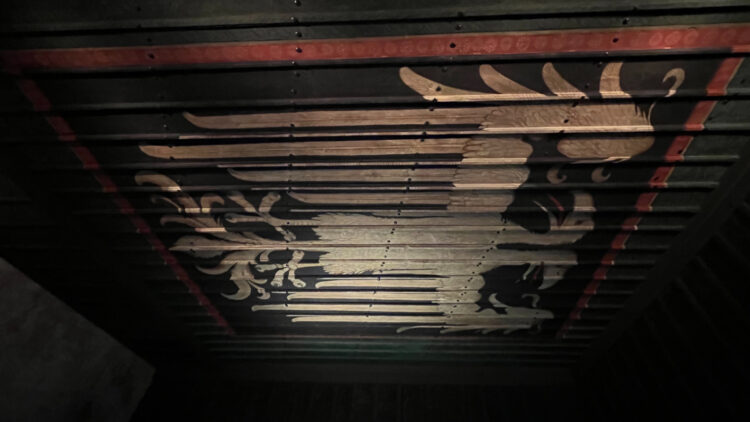
The Palas rests on foundations from 1200 but much of the upper floors were rebuilt throughout history. The Nazis were keen on the symbolic historic importance of Nuremberg and restored much of the palace in the 1930s to resemble a late medieval castle. Much of this effort was destroyed within a decade with the castle severely damaged in air raids that destroyed 90% of the old town building in Nuremberg.
Although much of the palace had to be rebuilt, it is still interesting to see the inside of the castle as many of the fittings and decorations such as wall panels and wooden ceilings are originals that were safely hidden away during the war.
The Kaisersaal was the center of activity during imperial visits. It now has an exhibition explaining how the empire functioned including the role of the emperor and free imperial cities (of which Nürnberg often considered itself to be the first among equals).
The Adlerdecke (eagle ceiling) is probably the best-known decoration in the castle. Here, the imperial double-headed eagle from the 15th century is in heraldic reverse color order — yellow on black background. The real reason is unknown but it has been suggested that as it was on the ceiling of a bedroom, it allowed the royal prince to see the colors correctly when closing his eyes to fall asleep.
Imperial Regalia in the Kaisersburg Castle in Nuremberg
A highlight of any visit to Nuremberg should have been to see the Imperial Regalia (Reichskleinodien) including the Crown, the Imperial Orb, the Imperial Scepter, the Holy Lance, and the Imperial Sword used during the coronation of the Holy Roman Emperor (usually in Aachen or Frankfurt am Main).
These were preserved in Nuremberg — mostly in the Heilig-Geist-Spital — from 1424 to 1796. It was then moved for safekeeping from Napoleon’s troops to Regensburg and eventually Vienna. Following the dissolution of the Holy Roman Empire in 1806, the newly crowned Austrian Emperor refused to return the treasure to Nuremberg. The Nazis briefly returned the regalia to Nuremberg but the American military sent it back to Vienna in 1946 where it may still be seen in the Hofburg. The treasure is apparently never shown outside Austria, as Nuremberg might test how a non-Austrian court interprets Emperor Sigismund entrusting the Imperial Regalia to Nuremberg “to everlasting preservation”.
Several good copies of the Imperial Regalia exist and are displayed in various German cities, including in the Fembo House in Nuremberg. In the Kaiserburg, a modern copy of the imperial crown hovers over a model of Nürnberg (1549) — the oldest topographic model of a German city. Copies of the Imperial Orb, the Imperial Scepter, and the Holy Lance are also on display as well as a copy of Albrecht Dürer’s painting of Kaiser Sigismund. (The original and accompanying painting of Charlemagne is in the Germanisches Nationalmuseum.)
Kaiserburg-Museum in the Kemenate
The Kaiserburg-Museum is a branch of the Germanisches Nationalmuseum and is used to display some of the vast collection of weaponry and armory. The Kemenate (bower) was almost completely destroyed in the second world war and only rebuilt in 1971.
The exhibition includes excavation findings and the history of the castle. Many may find the armory and weaponry of more interest, as the collection far exceeds what is on display in many smaller castles and museums. The collection of historical protective and assault weapons such as body armor, firearms and staff weapons, shields, and other accessories show how the fighting techniques employed at castles changed over the centuries.
Deep Well / Tiefer Brunnen
The Deep Well (Tiefer Brunnen) is as the name says a deep well — the shaft goes 50 m down solid rock. The well dates from at least the 14th century and is now covered by a well house. The lower stone floors are from 1563 but the half-timbered higher floors are reconstructions from 1951.
The well is only shown on guided tours — times are posted on the door. During the tour, a platform with candles and a camera is lowered and hoisted back up.
Sinwellturm Tower
The imposing Sinwellturm dates from the late 13th century although the top is from the Renaissance. It is a long spiral staircase to the top for fantastic views of Nuremberg and a few photos showing the destruction of the castle and city in the Second World War. The wooden framework of the roof escaped war damage.
The name Sinnwell is wordplay from old German and means “extremely round” or mighty round to describe its physical attributes but also that its appearance of impregnability should warn off attackers from the start. Its purpose was a watchtower and it could also function as a keep.
Nuremberg Castle (Kaiserburg) Visitors Information
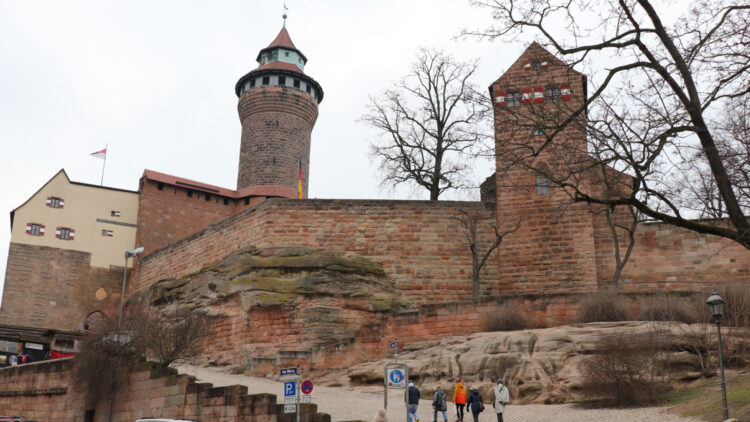
Most of the interior of the Kaiserburg, except the deep well, is visited without a guided tour. Access to many of the terraces, courtyards, and gardens is free — if not planning to buy a ticket, simply stroll around until reaching the entrances where tickets are inspected. The views from the free terraces of the old town are very photogenic too.
Opening Hours of the Kaiserburg in Nuremberg
The opening hours of the Kaiserburg Nürnberg are conveniently long. The castle is open:
- April to September: daily from 9:00 to 18:00
- October to March: daily from 10:00 to 16:00
The Kaiserburg is thus open on Mondays and only closed on January 1, Faschingsdienstag, and December 24, 25, and 31.
The Burggarten (castle gardens) are open mid-April from October during daylight hours — opening at 8:00 at the earliest and closing at 20:00 at the latest. The gardens are closed from November to mid-April.
Tickets for the Imperial Castle in Nuremberg
Children under 18 years are admitted free of charge to the castle. For adults the following tickets are available:
- €5.50 — Admission to the Palas with Double Chapel and the Imperial Castle Museum.
- €3.50 — Admission to the Deep Well and Sinwell Tower.
- €7 — Imperial Castle Combination Ticket / Gesamtkarte Kaiserburg: full admission all of the above. The Nürnberg City Card is accepted.
The Deep Well may only be seen on a guided tour (included in ticket prices but limited tours) while the rest of the castle may be explored freely. An audio guide is good value and useful at €2.
Admission to the gardens and some terraces is free.
Admission is also covered by the Bavarian Castles annual and two-week passes, which are excellent value when traveling in Bavaria.
Transportation to the Kaiserburg in Nuremberg
The Kaiserburg Nürnberg (Imperial Castle) is in the far north of the old town of Nuremberg. From most parts of the old town, and even the main station at the opposite southern end of the town center, walking is the most sensible option.
The closest public transportation stops are:
- Tram 4 — stop “Tiergärtnertorplatz”
- Bus 36 — stop “Burgstraße”
- U-Bahn U1 — station “Lorenzkirche”
Nürnberg City Card: Save on Sightseeing in Nuremberg
Two discount deals are worth considering to save on sightseeing when visiting Nuremberg (Nürnberg):

A day ticket valid for admission to all Nuremberg city municipal museums is €10.50 and gives admission to the Albrecht-Dürer-Haus, Museum Tucherschloss und Hirsvogelsaal, Stadtmuseum Fembo-Haus, Spielzeugmuseum (Toys), Museum Industriekultur, Nuremberg Trial Memorial, and the Dokumentationszentrum Reichsparteigelände. It is available from all participating museums.
The Nürnberg City Card is around €33 and covers all public transportation in Nuremberg and Fürth for 48 hours. It gives free admission to the Imperial Castle Nuremberg (Kaiserburg), Deutsches Museum Nuremberg, Germanisches Nationalmuseum, Albrecht Dürer House, Neues Museum, Toy Museum, Documentation Center Nazi Party Rally Grounds Interim Exhibit (main exhibition closed until 2025), Memorium Nuremberg Trials, DB Museum (German Railways Museum), Museum for Communication, Museum of Industrial Culture with the School Museum, City Museum at Fembo House Permanent Exhibit: A Crown – Power – History, Museum Tucher Mansion, Bavarian Bible Museum, Museum of Natural History, towerofthesenses, Kunsthalle Nuremberg, Kunstvilla Nuremberg, Kunsthaus Nuremberg, Museum Executioner’s House, Zoo Nuremberg, Children’s Museum, Red Cross Museum, Motor Museum Merk, Faber-Castell Stately Home with the Museum “Alte Mine”, Bratwurst Museum, Jewish Museum Franconia, Fürth, City Museum Fürth, and Ludwig Erhard Center Fürth. It also gives savings on guided tours and further events.
More on Traveling to Nürnberg:

- Buy a Nürnberg City Card to save on sightseeing and transportation.
- Top Sights to See in Nuremberg:
- Visit the Nuremberg Trials Memorial (Courtroom 600)
- Reichsparteitagsgelände (Nazi Party Rally Grounds)
- Visit the Germanisches Nationalmuseum — the largest cultural history museum in Germany.
- Visit the Kaiserburg — Imperial Castle in Nuremberg
- Visit the Albrecht-Dürer-Haus Museum where the artist lived and worked for two decades.
- Visit the DB German Railways Museum
- Visit the Nuremberg Christmas Market (Nürnberger Christkindlesmarkt)
- Transportation to Nuremberg in Bavaria
- Traveling by Train to Nuremberg – German Railways Timetables to Nuremberg
- Book Flights on Lufthansa, KLM, Eurowings or Air France.
- Cheap Flights to Nuremberg Airport (NUE)
- Transportation to Nuremberg Airport (NUE)
- Transportation from Munich Airport (MUC) to Nuremberg
- Nuremberg hotels are generally less pricey than those in Frankfurt or Munich.
- Adidas Factory Outlet Stores — half an hour north of Nuremberg but a very popular stop en route to Bamberg.
- Suntransfers give online quotations without requiring flight and personal details.
